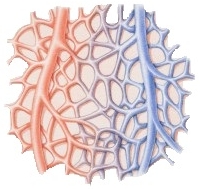Definition:
Perfusion is the blood flow at the capillary level in tissue.
Perfusion specifies the amount of blood reaching the tissue of interest and is measured in units of ml/100g-min.
Adequate perfusion is essential:
Perfusion is the means by which blood provides nutrients and removes cellular waste. Adequate tissue perfusion-when supply meets demand-is necessary to maintain healthy vital tissue.
Insufficient perfusion (ischemia)-when demand exceeds supply-induces an oxygen debt and causes a build up of toxic cellular waste, stressing the vitality of the tissue. Untreated ischemia leads to cellular dysfunction, loss of organ function, and even cellular death i.e., tissue infarction.
Excessive perfusion (hyperemia) -when supply exceeds demand-is frequently associated with formation of edema in the associated tissue.
Consequently, maintaining adequate perfusion (via managing perfusion pressure and vascular patency) is vital to maintaining healthy tissue.

Image courtesy of: Essentials of Nutrition: A Functional Approach. Vol. 1. December 2012.
Benefits of perfusion monitoring:
Much of clinical management is focused on maintaining adequate perfusion.
Until recently, clinicians used indirect measures such as arterial and intracranial blood pressure to assess adequacy of perfusion.
Today, the Bowman Perfusion Monitor® is used to directly assess cerebral tissue perfusion, in real-time, at the bedside.
This technology provides multiple benefits:
-Real-Time Monitoring provides immediate, actionable information
-Early detection of ischemia enables early intervention and the opportunity to improve patient outcomes
-Insight into the effectiveness of a therapeutic intervention and the assurance of knowing the patient’s clinical state


